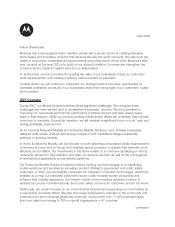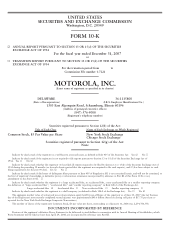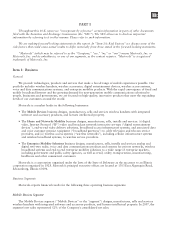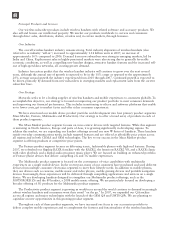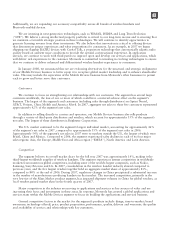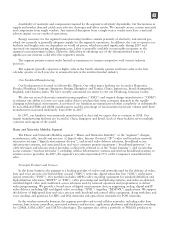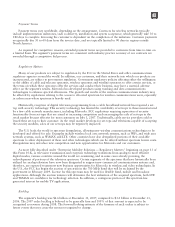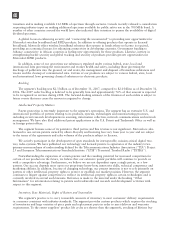Motorola 2007 Annual Report Download - page 13
Download and view the complete annual report
Please find page 13 of the 2007 Motorola annual report below. You can navigate through the pages in the report by either clicking on the pages listed below, or by using the keyword search tool below to find specific information within the annual report.
Availability of materials and components required by the segment is relatively dependable, but fluctuations in
supply and market demand could cause selective shortages and affect results. We currently source certain materials
and components from single vendors. Any material disruption from a single-source vendor may have a material
adverse impact on our results of operations.
Energy necessary for the segment’s manufacturing facilities consists primarily of electricity and natural gas,
which are currently in generally adequate supply for the segment’s operations. In addition, the cost to operate our
facilities and freight costs are dependent on world oil prices, which increased significantly during 2007 and
increased our manufacturing and shipping costs. Labor is generally available in reasonable proximity to the
segment’s manufacturing facilities. However, difficulties in obtaining any of the aforementioned items or a
significant cost increase could affect the segment’s results.
The segment permits returns under limited circumstances to remain competitive with current industry
practices.
The segment typically experiences higher sales in the fourth calendar quarter and lower sales in the first
calendar quarter of each year due to seasonal trends in the wireless handset industry.
Our Facilities/Manufacturing
Our headquarters is located in Libertyville, Illinois. Our other major facilities are located in Plantation,
Florida; Flensburg, Germany; Singapore; Beijing, Hangzhou and Tianjin, China; Jaguariuna, Brazil; Basingstoke,
England; and Chennai, India. We have recently announced our intent to exit our Flensburg, Germany facility.
We also use several electronics manufacturing suppliers (“EMS”) and original design manufacturers (“ODM”)
to enhance our ability to lower our costs and/or deliver products that meet consumer demands in the rapidly-
changing technological environment. A portion of our handsets are manufactured either completely or substantially
by non-affiliated EMS and ODM manufacturers and the percentage of total manufactured unit volume with these
manufacturers increased moderately from 2006 to 2007.
In 2007, our handsets were primarily manufactured in Asia and we expect this to continue in 2008. Our
largest manufacturing facilities are located in China, Singapore and Brazil. Each of these facilities serves multiple
countries and regions of the world.
Home and Networks Mobility Segment
The Home and Networks Mobility segment (“Home and Networks Mobility” or the “segment”) designs,
manufactures, sells, installs and services: (i) digital video, Internet Protocol (“IP”) video and broadcast network
interactive set-tops (“digital entertainment devices”), end-to-end video delivery solutions, broadband access
infrastructure systems, and associated data and voice customer premise equipment (“broadband gateways”) to
cable television and telecom service providers (collectively, referred to as the “home business”), and (ii) wireless
access systems (“wireless networks”), including cellular infrastructure systems and wireless broadband systems, to
wireless service providers. In 2007, the segment’s net sales represented 27% of the Company’s consolidated net
sales.
Principal Products and Services
In the home business, the segment is a leading provider of end-to-end networks used for the delivery of video,
data and voice services over hybrid fiber coaxial (“HFC”) networks, digital subscriber line (“DSL”) and passive
optical networks (“PON”). Our portfolio includes: MPEG video encoding equipment for standard-definition and
high-definition television (“HDTV” or “HD”); video processing and multiplexing systems; and video-on-demand,
switched digital video and conditional access solutions used by network operators and programmers to deliver
video programming. We provide a broad array of digital entertainment devices supporting analog, digital and IP
video delivery including HD and digital video recording (“DVR”) (together, “HD/DVR”) applications. We support
the delivery of high-speed data and voice services with head-end and central office equipment, along with data and
voice modems and gateways for HFC and DSL networks and optical line terminals for PON networks.
In the wireless networks business, the segment provides end-to-end cellular networks, including radio base
stations, base station controllers, associated software and services, application platforms and third-party switching
for CDMA, GSM, iDEN
»
and UMTS technologies. The segment also offers a portfolio of WiMAX products to
5


